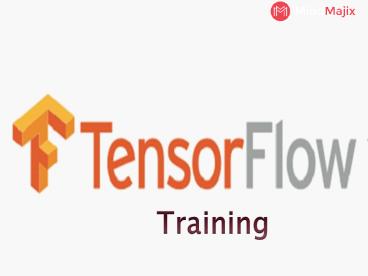Get The Best TensorFlow Online Training at Mindmajix PowerPoint PPT Presentation
Title: Get The Best TensorFlow Online Training at Mindmajix
1
(No Transcript)
2
TensorFlow Agenda
- Introduction To TensorFlow
- Introduction To Deep Learning
- Fundamentals Of Neural Networks
- Fundamentals Of Deep Networks
- Convolutional Neural Networks (CNN)
- Recurrent Neural Networks (RNN)
- Restricted Boltzmann Machine(RBM) And Autoencoders
3
What is TensorFlow?
- ? TensorFlow is a multipurpose open source
so2ware library for numerical computation using
data flow graphs. It has been designed with deep
learning in mind but it is applicable to a much
wider range of problems. - ? But what does it actually do? TensorFlow
provides primitives for defining functions on
tensors and automatically computing their
derivatives.
4
But whats a Tensor?
- Formally, tensors are multilinear maps from
vector spaces to the real numbers ( vector space,
and dual space) - A scalar is a tensor ( )
- A vector is a tensor ( )
- A matrix is a tensor ( )
- Common to have fixed basis, so a tensor can be
represented as a multidimensional array of
numbers.
5
Introduction To Deep Learning
- Deep Learning is machine learning technique that
learns features and tasks directly from data. - Data can be images, text, or sound.
6
What is Artificial Intelligence?
- Every aspect of learning or any other features
of intelligence can in principle be so precisely
described that a machine can be made to simulate
it. An attempt will be made to find how to make
machine us language, form abstractions and
concepts, solve kinds of problems now reserved
for humans, and improve themselves.
7
Why Artificial Intelligence
8
Limitations of Machine Learning
- There are a few key limitations of machine
learning approaches that impact on their
usefulness for certain tasks, as well as their
ability to function in real-world environments.
Machine learning algorithms function very well on
tasks related to familiar data from a training
set. Limitations tend to surface when the
algorithm tries to incorporate new data. As these
systems advance, they are quickly becoming better
at categorizing familiar data and performing
tasks such as image or speech recognition.
9
The Math behind Machine Learning Linear
Algebra ScalarsVectorsMatricesTensorsHyperplan
es The Math Behind Machine Learning
Statistics ProbabilityConditional
ProbabilitiesPosterior ProbabilityDistributions
Samples vs PopulationResampling
MethodsSelection BiasLikelihood
10
Defining Neural Networks
- Neural networks are a set of algorithms, modeled
loosely after the human brain, that are designed
to recognize patterns. They interpret sensory
data through a kind of machine perception,
labeling or clustering raw input. The patterns
they recognize are numerical, contained in
vectors, into which all real-world data, be it
images, sound, text or time series, must be
translated. -
(OR) - A neural network is a series of algorithms that
attempts to identify underlying relationships in
a set of data by using a process that mimics the
way the human brain operates. Neural networks
have the ability to adapt to changing input so
the network produces the best possible result
without the need to redesign the output criteria.
The concept of neural networks is rapidly
increasing in popularity in the area of
developing trading systems.
11
Deep Learning
- The important innovation in deep learning is a
system that learns categories incrementally
through its hidden layer architecture, defining
low-level categories like letters before moving
on to higher level categories such as words. In
the example of image recognition this means
identifying light/dark areas before categorising
lines and then shapes to allow face recognition.
Each neuron or node in the network represents one
aspect of the whole and together they provide a
full representation of the image. Each node or
hidden layer is given a weight that represents
the strength of its relationship with the output
and as the model develops the weights are
adjusted.
12
- LAYER 1 Algorithm first learns to recognise
pixels and then edges and shapes - LAYER 2 Learns to identify more complex shapes
and features like eyes and mouths - LAYER 3 Learns which shapes and objects can be
used to identify a human face
13
Convolution Neural Network
14
15
(No Transcript)
16
Recurrent Neural Network Model
17
Why Recurrent Neural Network
18
(No Transcript)
19
Long-Short Term Memory(LSTM)
20
Output Gate
21
Forget Gate
22
Input Gate
23
LSTM
24
Simplified LSTM
25
Restricted Boltzmann Machine
26
Restricted Boltzmann Machine
27
INDIA 91-9246333245 USA 1-201 3780
518 Email info_at_mindmajix.com Websitehttps//min
dmajix.com/ Urlhttps//mindmajix.com/tensorflow-t
raining
28
(No Transcript)

